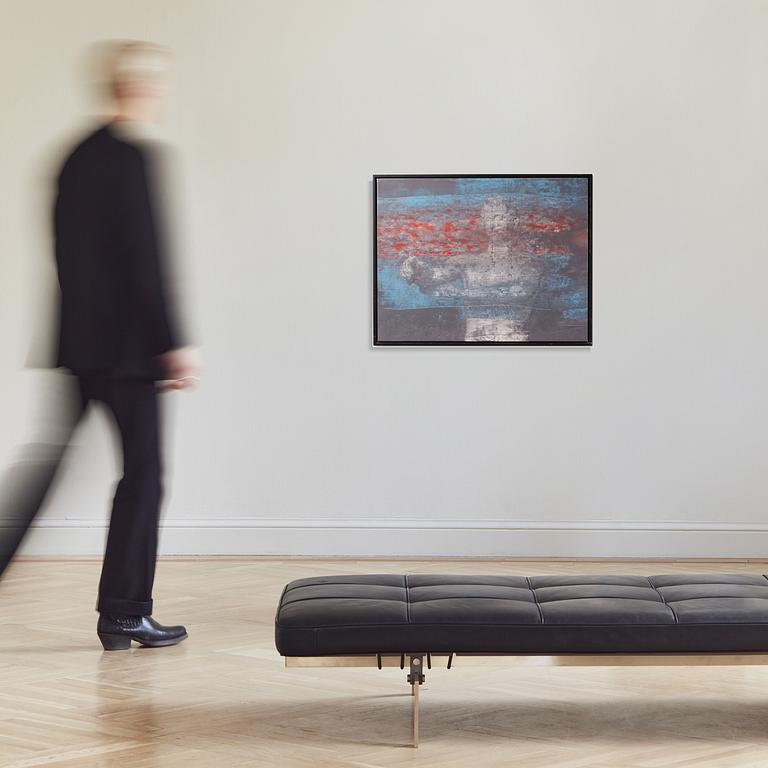Ola Billgren
Untitled
Certified by Claus Leger verso. Executed in 2001. Oil on canvas 73 x 94 cm.
Provenance
The artist's family.
More information
“We made a longer trip to Italy in 1995. We traveled to Pompeii, we visited Tivoli and Villa d'Este. Ola photographed a lot during the whole trip. Once back home, he took the pictures and let them inspire him in his painting," says Anita Nilsson Billgren.
The trip and the impressions resulted in an exhibition at Susanne Ottesen's in Copenhagen. The exhibition was called "Ola Billgren, Maleri Fotogravure" and the paintings testified to the importance of the journey and the importance of the impressions Ola Billgren brought back to Sweden. Behind the artist's abstract surfaces, classical idioms, architectural details such as loggias and temple gables, and sculptures with their antiquated appearance were reminiscent of ancient Italy.
For Ola Billgren, the photographic image had always been important to his working process. In the 1960s, when his art reproduced his immediate surroundings with photorealistic clarity, inspiration came from film and literature, the illustrated press and contemporary everyday life. In the 1970s, Billgren moved on to freer painting and was able to explore the possibilities and conditions of painting with greater artistic freedom. He had now become an established artist who exhibited around the world and represented Sweden at the Venice Biennale in 1971. Billgren's almost academic and almost scientific approach to painting meant that he never stopped. Seeking the challenge, the 1980s broke with the myopia of the earlier years in his choice of subjects and now the artist looked out over cities and cityscapes, both from the perspective of the pedestrian and from the tops of cathedrals, in cities across Europe. Breathtaking perspectives and silhouettes unfolded before the viewer who was offered a journey from the spire of Cologne to Braubach and Seville in the artist's various, often monumental, canvases. The red color broke through and from merely dancing over the surface, the color spread out over the canvases and Billgren created in the early 1990s almost monochrome paintings, where the motifs under layers of color could be sensed in the background. The photographic image was still important as a model and inspiration, but the painterly effects of color on the canvas were given increasing weight and thus carried Billgren's painting forward.
Ola Billgren has been called both a theorist and a sensualist, and in his works he managed to capture the historical and the contemporary in one and the same image. Billgren's paintings are characterized by both duality and ambiguity, both in expression and content, and the dreamlike presence is unmistakable, from the photorealistic works of the 1960s to the romantic approach of late painting. "Ola Billgren's realism often gives precisely this impression of wanting to hold on or stand against time." Douglas Feuk writes this on page 61 of the large book "Ola Billgren, Måleri - Paintings" (2000). He writes it in relation to Billgren's paintings from the 1960s, and describes the paintings as showing stagnant hospital corridors or messy living rooms, far away from the noise of the world outside. What is interesting is that it feels equally relevant to Billgren's late paintings.
In the auction's painting, the artist was clearly inspired by his trip to Italy a few years earlier. It was still the present and the impressions of the time that inspired him, but it was a present seen through a historical grid and moved another step away from the "authentic" by using the photographic image as a model. The artist was attracted by history, by our common cultural heritage and what has shaped our image of antiquity.
An initially clear painting has been given a dreamlike and suggestive tone by the artist's careful hand, and the red and blue paint has been carefully applied to the surface in an unmistakably Billgrenian manner. The treatment of the surface makes the motif itself appear distant to the viewer and, like the stories of antiquity, which have been transformed over the centuries by human traders and eager writers, the remains of the Romans appear only as fleeting dreams to our eyes. The dream of history becomes one with the dream of life and the dream of being in the present. The painting in the auction is one of the very last paintings that Ola Billgren completed before his death and becomes for us a poetic memento mori motif that testifies to a virtuoso painter's highly intense and relevant conversation with history.
Artist
Ola Billgren was born in 1940 in Copenhagen but based his career in Sweden. Billgren was self-taught, having only been trained by his parents Hans and Grete Billgren. Ola worked within the mediums of graphic art, watercolour, collage, photography, film, and scenography. He was also an author and culture critic. Known for his versatility, Billgren cultivated a relationship between art and reality in his work.
During the 1960s, he transitioned from abstract expressionism to photographic realism. Over time, his paintings evolved into a fusion of abstract and photorealistic styles, resulting in romantic landscapes where he examined the interplay of light and color. Forms dissolved, and colors were reduced to monochrome, single-colored surfaces that were richly worked and varied.
In the late 1980s, he returned to urban environments in large cityscapes, often painted from a high perspective but maintaining the impressionistic approach seen in his landscapes. Ola Billgren's influence on recent decades of art has been significant. His work is represented in institutions such as Musée National d'art Moderne Centre George Pompidou in Paris and Moderna Museet in Stockholm.















































